The Oppo Reno5 Pro 5G is located just below the Reno5 Pro+ 5G in the Oppo smartphone lineup and comes with a similar feature set. Main hardware differences are the Mediatek MT6889Z Dimensity chipset instead of the Snapdragon 865 in the Plus model and the lack of a tele module in the main camera. But both models use the same 6.55-inch AMOLED display with 1080- x 2400-pixel resolution and 90 Hz refresh rate.
Key display specifications:
- AMOLED screen
- Size: 6.55 inches (89% screen-to-body ratio)
- Dimensions: 159.7 x 73.2 x 7.6 mm (6.29 x 2.88 x 0.30 in)
- Resolution: 1080 x 2400 pixels
- Aspect ratio: 20:9, 402 ppi
- Refresh rate: 90 Hz
With the Oppo Reno5 Pro 5G and Pro+ 5G sharing the same display specs, one would expect the Display test results to be very close. We have confirmed this by putting the Oppo Reno5 5G through the complete DXOMARK Display test protocol.
The Reno5 Pro 5G achieves a DXOMARK Display overall score of 81 versus the Plus models 83. Results across almost all attributes are very similar (within a one or two-point margin). The only noticeable difference we encountered was for motion, where the Reno5 Pro 5G shows slightly more frame drops in video and less reactive video playback, resulting in a motion score that is five points lower.
Given the almost identical results, we are posting only this short article for the Oppo Reno5 Pro 5G. For the full set of measurements as well as a complete analysis, please click on the link below and read the full review of the Oppo Reno5 Pro+ 5G.
Oppo Reno5 Pro+ 5G Display review
 Oppo Reno5 Pro 5G
Oppo Reno5 Pro 5G


 66th
66th
 12th
12th
Pros
- Fairly faithful color in indoor and low-light conditions
- Well-adapted brightness levels provide good readability indoors
- No frame mismatches when playing video games
Cons
- Very strong video contrast rendering results in unpleasant HDR10 videos
- Image rendering is modified in outdoor light to improve readability, resulting in unnatural rendering of both contrast and color
- Frame mismatches impact the overall video playback experience




DXOMARK encourages its readers to share comments on the articles. To read or post comments, Disqus cookies are required. Change your Cookies Preferences and read more about our Comment Policy.